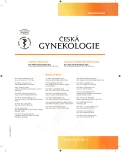Evaluation of p16 protein in the managementof cervical dysplasia
Authors:
M. Pešek 1; I. Kinkorová 2; R. Ferko 3; A. Ürgeová 1; J. Bouda 1
Authors‘ workplace:
Gynekologicko-porodnická klinika LF UK a FN, Plzeň, přednosta doc. MUDr. Z. Novotný, CSc.
1; Bioptická laboratoř Plzeň, s. r. o.
2; Šiklův patologicko-anatomický ústav FN, Plzeň, přednosta prof. MUDr. M. Michal
3
Published in:
Ceska Gynekol 2013; 78(2): 195-199
Overview
Objective:
Protein p16 as an important cell-cycle inhibitor is a promising diagnostic and prognostic factor of cervical dysplasia. In our study we evaluate the impact of p16 protein evaluation on management of cervical dysplasia.
Design:
Retrospective study.
Setting:
Department of Obstetrics and Gynecology, Medical Faculty Pilsen, Charles University Prague.
Methods:
A retrospective study was performed on 122 consecutive patients with colposcopically-directed cervical biopsy (CDB) with following excisional procedure (LEEP or cold-knife conisation). P16 expression in the specimen from CDB was independently evaluated using immunohistochemistry in all patients. Relation among CDB histology, p16 expression, and final histology from excisional procedure was analysed.
Results:
In our series, we identified 44 CIN 1 and 61 CIN 2/3 in CDB specimens. In the CIN 1 group, 15 cases (34.1%) were p16 negative and 29 (65.9%) cases were p16 positive. In CIN 1 p16 negative group, only 2 of 15 patients (13.3%) had CIN 2/3 in the final histology comparing to 19 of 29 patients (65.5%) in CIN 1 p16 positive group (statistically signifiant,p < 0,05; Wilcoxon test). In CIN 2/3 group, 60 (98.4%) specimen were p16 positive and 57 patients (93.4%) had also CIN 2/3 in the final histology.
Conclusion:
In our study of 122 patients with CDB we found that in group of CIN 1 patients, p16 evaluation had significant predictive value for final histology. In the group of patients with CIN 2/3, 98% specimens were p16 positive and therefore p16 evaluation had no prognostic impact on final histology. Prospective study is needed to confirm this data.
Keywords:
protein p16 – colposcopically-directed cervical biopsy – CDB – immunohistochemistry
Sources
1. American College of Obstetricians and Gynecologists. ACOG practice bulletin no. 66. Management of abnormal cervical cytology and histology. Obstet Gynecol, 2005, 106, p. 645–664.
2. Bates, S., Parry, D., Bonneta, L., et al. Absence of cyclin D/cdk complexes in cells lacking functional retinoblastoma protein. Oncogene, 1994, 9, p. 1633–1640.
3. Del Pino, M., Garcia, S, Fusté, V., et al. Value od p16 as a marker of progression/regression in cervical intraepithelial neoplasia grade 1. Am J Obstet Gynecol, 2009, 201, p. 488.
4. Focchi, GR., Silva, ID., Nogueira-de-Souza, NC., et al. Immunohistochemical expression of p16(INK4A) in normal uterine cervix, nonneoplastic epithelial lesions, and low-grade squamous intraepithelial lesions. J Low Genit Tract Dis, 2007, 11, p. 98–104.
5. Galgano, MT., Kastle, PE., Kristen, A., et al. Using biomarkers as objective standards in the diagnosis of cervical biopsie. Am J Surg Pathol, 2010, 34, p. 1077–1087.
6. Klaes, R., Banner, A., Friedrich, T., et al. P16 INK4a immunohistochemistry improves interobserver agreement in the diagnosis of cervical intraepithelial neoplasia. Am J Surg Pathol, 2002, 26, p. 1389–1399.
7. Liang, J., Mittal, KR., Wei, JJ., et al. Utility of p16INK4a, CEA, Ki 67, P53 and ER/PR in the diferential diagnosis of benign, premalignant and malignant glandular lesions of the uterine cervix. Int J Gynecol Pathol, 2007, 26, p. 71–75.
8. Murény, N., Ring, M., Killalea, AG., et al. P16INK4a as a marker for cervical dyskaryosis: CIN and CGIN in cervical biopsies and ThinPrep smears. J Clin Pathol, 2003, 56, p. 56–63.
9. O´Neill, CJ., McCluggage, WG. P16 expression in the female genital tract and its value in diagnosis. Adv Anat Pathol, 2006, 13, p. 8–15.
10. Queiroz, C., Silva, TC., Alves, VA., et al. P16(INK4a) expression as a potential prognostic marker in cervical pre-neoplastic and neoplastic lesions. Pathol Res Pract, 2006, 202, p. 77–83.
11. Rejtar, A., Vojtěšek, B. Obecná patologie nádorového růstu. 1. ed. Praha: Grada Publishing, 2002, 106–128 s.
12. Schifmann, M., Khan, MJ., Salomon, D., et al. A study of the impact of adding HPV types to cervical cancer screening and triage test. J Natl Cancer Indy, 2005, 97, p. 147–150.
13. Wang, SS., Trunk, M., Schifmann, M., et al. Validation of p16INK4a as a marker of oncogenic human papillomavirus infection in cervical biopsies from a population-based cohort in Costa Rica. Cancer Epidemiol Biomarkers Prev, 2004, 13, p. 355–1360.
Labels
Paediatric gynaecology Gynaecology and obstetrics Reproduction medicineArticle was published in
Czech Gynaecology

2013 Issue 2
Most read in this issue
- Transfusion-related acute lung injury (TRALI) – review
- Reccurent pregnancy loss – review
- Evaluation of p16 protein in the managementof cervical dysplasia
- Hyperlipidaemia in pregnancy
